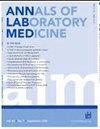Role of the QuantiFERON-Monitor in Assessing the Immune Status of Patients with Acute Respiratory Failure in Adult Intensive Care Units: A Prospective, Observational Study.
IF 3.9
2区 医学
Q1 MEDICAL LABORATORY TECHNOLOGY
引用次数: 0
Abstract
Background The utility of the QuantiFERON-Monitor (QFM, Qiagen), a tool developed to assess general immune function, remains insufficiently explored in critically ill patients with acute respiratory failure (ARF). Therefore, we used the QFM to evaluate the immune function of patients with ARF at intensive care unit (ICU) admission and monitored QFM changes based on disease severity and clinical outcome correlations. Methods We evaluated the immune function of 99 patients with ARF in an ICU setting. The QFM was evaluated upon ICU admission, day 7 post-ICU admission, and discharge. Their results were compared with those of five healthy controls. Results The QFM levels at ICU admission were significantly lower in patients with ARF than in healthy controls (median IUs/mL: 5.5 vs. 465.0, respectively). The QFM levels in patients with coronavirus disease 2019 or pneumonia (9.2 and 7.9 IUs/mL, respectively) were higher than those in patients with acute respiratory distress syndrome or septic shock (4.9 and 3.6 IUs/mL, respectively). On day 7, the QFM levels increased to 8.3 IUs/mL and reached 16.7 IUs/mL at discharge. At ICU admission, patients requiring ventilator support had lower QFM levels than those requiring nasal prong or high-flow nasal cannula support. Those who died in the ICU had significantly lower QFM levels (4.0 IUs/mL) at ICU admission than those who survived (5.8 IUs/mL). Conclusions Reduced QFM levels among patients with severe ARF reflect impaired cellular immune responses and suggest that QFM may serve as a practical tool for early risk stratification and immune monitoring in ICU settings.定量干扰素监测器在评估成人重症监护病房急性呼吸衰竭患者免疫状态中的作用:一项前瞻性观察性研究
QuantiFERON-Monitor (QFM, Qiagen)是一种用于评估一般免疫功能的工具,但在急性呼吸衰竭(ARF)危重患者中的应用仍未得到充分探索。因此,我们使用QFM来评估ARF患者在重症监护病房(ICU)入院时的免疫功能,并根据疾病严重程度和临床结局相关性监测QFM的变化。方法对ICU收治的99例ARF患者进行免疫功能评估。在ICU入院、ICU入院后第7天和出院时评估QFM。他们的结果与五名健康对照者的结果进行了比较。结果ARF患者入院时的QFM水平明显低于健康对照组(中位iu /mL: 5.5 vs 465.0)。2019冠状病毒病和肺炎患者的QFM水平(分别为9.2和7.9 IUs/mL)高于急性呼吸窘迫综合征和感染性休克患者(分别为4.9和3.6 IUs/mL)。第7天,QFM水平上升至8.3 IUs/mL,放电时达到16.7 IUs/mL。在ICU入院时,需要呼吸机支持的患者的QFM水平低于需要鼻尖或高流量鼻插管支持的患者。ICU死亡患者入院时QFM水平(4.0 iu /mL)明显低于存活患者(5.8 iu /mL)。结论严重急性肾功能衰竭患者QFM水平降低反映了细胞免疫反应受损,提示QFM可作为ICU环境中早期风险分层和免疫监测的实用工具。
本文章由计算机程序翻译,如有差异,请以英文原文为准。
求助全文
约1分钟内获得全文
求助全文
来源期刊

Annals of Laboratory Medicine
MEDICAL LABORATORY TECHNOLOGY-
CiteScore
8.30
自引率
12.20%
发文量
100
审稿时长
6-12 weeks
期刊介绍:
Annals of Laboratory Medicine is the official journal of Korean Society for Laboratory Medicine. The journal title has been recently changed from the Korean Journal of Laboratory Medicine (ISSN, 1598-6535) from the January issue of 2012. The JCR 2017 Impact factor of Ann Lab Med was 1.916.
 求助内容:
求助内容: 应助结果提醒方式:
应助结果提醒方式:


